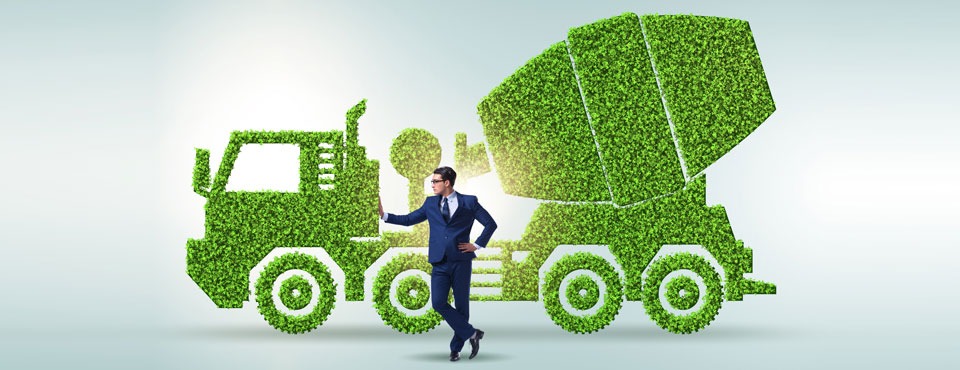Courtesy : theconstructor.org
Green cement
The majority of these are based on technological advances that include energy-efficient, low carbon production methods, new cement formulations, geopolymers, carbon-negative cements, and new concrete products. Additionally, green cement production reduces cement intake, and its major raw materials include discarded industrial wastes like blast furnace slag and fly ash.
Ekkomaxx cement, magnesium oxychloride cement, geopolymer cement, ferrocrete, calcium sulfoaluminate cement, and sequestrated carbon cement are some examples of green cement. Some of these products have been commercialized and used in various projects whereas a number of these cements have not been utilized broadly in construction projects but possess great potential to be used.
Types of Green Cement
1. Ekkomaxx Cement
It is a type of green cement produced by Ceratech company in the united states that is composed of 95% fly ash and 5% renewable liquid additives. Based on standards such as the International Code Council and United States Green Building Council, this cement, which is manufactured by Ceratech Company, has nearly zero carbon footprint.
Not only does the process of cement production declined the use of virgin material by 95% but also water requirement decreased by half.
The main characteristics of Ekkomax cement are high early strength, resilience, crack resistance, low chloride permeability, sulphate attack resistance, durability, corrosion resistance which is more than three times of conventional cement, and the resistance to freezing and thawing is greater than that of normal cement.
2. Magnesium Oxychloride Cement
Magnesium Oxychloride Cement (MOC) is an environmentally friendly and carbon-neutral cement which is produced from two main materials namely: magnesium oxide (MgO) powder and a concentrated solution of magnesium chloride (MgCl2). These are byproducts from magnesium mining.
The MOC has great compressive strength and set quickly and MgO absorb CO2 from the atmosphere, but water can reduce its strength considerably. However, this weakness of MOC can be tackled to certain extent by introducing 15% of fly ash and the same amount of silica fume.
These additives fill the pore structure in MOC which makes the concrete denser. Consequently, both strength and durability of concrete is improved considerably. Furthermore, it is required to add phosphoric acid and soluble phosphates to improve the resistance of this type of green cement against warm water.
Finally, Magnesium Oxychloride Cement leads to the corrosion of steel, hence this type of cement cannot be used for construction reinforced concrete structure unless this problem is tackled.
3. Geopolymer cement
Geopolymer, which is also known as alkali-activated cement, is produced from aluminosilicates instead of the more environmentally damaging calcium oxide.
The aluminosilicates are obtained from industrial by-product like fly ash. The geopolymer cement is competitive with ordinary Portland cement in performance and cost, and it emits 95% less CO2 than the ordinary Portland cement.
3. Ferrocrete
The ferrocrete cement is manufactured by mixing silica and iron which are waste byproducts from steel and glass industry. This material mixture is then cured with CO2, and consequently, it potentially becomes carbon-negative material. The scientists at the University of Arizona invented ferrocrete.
4. Calcium Sulfoaluminate Cement
The calcium sulfoaluminate cement is produced of a kiln that requires a temperature of 1232.2C (2250F) rather than 1426.6 (2500F) of conventional cement. As a result, less CO2 would be released into the atmosphere. The calcium sulfoaluminate cement sets rapidly; gain 28-day strength of conventional concrete in 24 hours.
That is why it is used in projects where rapid setting of concrete is crucial such as bridge decks and airport runways. The calcium sulfoaluminate cement can be used as shrinkage compensating cement when higher quantity of gypsum is added.
This type of cement can achieve energy savings as high as 25% and provide environmental benefits by reducing CO2 emissions by around 20% when compared with Portland cement.
5. Sequestrated Carbon Cement
The Calera Corp. cement in California produced cement from seawater or brine mixed with CO2 that may be used as a Portland cement substitute. In this cement production process, CO2 rich gases are filtered through seawater.
The calcium and magnesium are stripped from the seawater and react with CO2 to produce high-quality cement, which is white, air-permeable and stronger than regular OPC.

6. Cement Produced Using Superheated Steam
The process of superheated steam can be used to change the cement particles in order to make them more reactive. In this process, the emitted CO2 can be captured after it has been separated.
7. Cement Produced with Reactive Hydrothermal Liquid-phase Densification
This type of cement is produced using the same raw materials as ordinary Portland cement, but at lower temperature and through different chemical reaction that produces less CO2 compared with traditional Portland cement production process.
This cement is blended with water and CO2 and reacts with CO2 to produce calcium carbonate and silica which eventually hardens to make concrete. This type of green cement is produced by SolidiaTechnology Company based in the United States, and has partnership with Lafarge to commercialiese the cement production technology.
Advantages
- Lowers carbon dioxide emission as it does not require as much heat during its production, releasing up to 80% less carbon dioxide.
- Makes use of industrial waste such as fly ash, silica fume, and last furnace that may require several acres of land to dispose it. As a result, it protects land from becoming a dumping ground and ultimately being destroyed.
- Requires less energy Since industrial by-products present in green cement, the energy needed in production is greatly reduced. Additionally, it withstands temperature fluctuations and hence decreases costs related to both heating and cooling.




